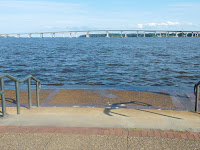I visited several towns along the NC coast with common Civil War histories. In each of these places, Union and Confederate troops clashed over control of waterways. Each had waterfront parks which remembered this history and gave locals a place for recreation near the water.

At Elizabeth City, in February of 1862, Union ships destroyed a group of Confederate boats that had been harassing U.S. shipments. The waterfront park had a boat ramp, a gazebo, and great views.

In Edenton, there was a pretty town square, and an antebellum home had been brought to the waterfront to act as the visitor center. Like Elizabeth City, this was a departure point for boats that were part of the Underground Railroad. In 1866, a small lighthouse was built on the Roanoke River; it had been recently restored and was open for visitors.
Washington, NC, also had a river lighthouse. After a land-and-naval battle there in 1862 (which for a time looked like a possible Confederate victory until Union reinforcements arrived), Washington was actually burned by the Union army when it finally left town.
After crossing one of the long, modern bridges leading into New Bern, I detoured to Union Point Park to get a panoramic view of all the area bridges and the waterfront. After being affected by the Union blockade during the war, this was a big commercial port in Reconstruction days. The park had fishing areas, a gazebo, a long walkway that includes an area where you can walk right up to the water, and interpretive exhibits that tell about history, wildlife, and scenery.
When I checked the time in New Bern, I determined I could still make it home if I left right away. This caused me to save my trip to Charleston for another time, and I drove well into the night to sleep in my own bed. The trip was GREAT, but it's good to be home!!
















